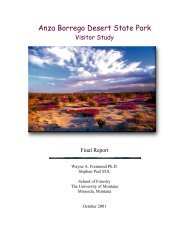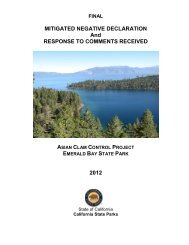Draft EIS/EIR for the San Luis Reservoir SRA Resource ...
Draft EIS/EIR for the San Luis Reservoir SRA Resource ...
Draft EIS/EIR for the San Luis Reservoir SRA Resource ...
You also want an ePaper? Increase the reach of your titles
YUMPU automatically turns print PDFs into web optimized ePapers that Google loves.
Appendix B. Biological Survey Forms and Project Area Vegetation<br />
Project Area Vegetation<br />
The following describes <strong>the</strong> vegetation of <strong>San</strong> <strong>Luis</strong> <strong>Reservoir</strong> State Recreation Area and <strong>the</strong><br />
DFG-managed wildlife areas. These areas include land around <strong>San</strong> <strong>Luis</strong> <strong>Reservoir</strong>, <strong>the</strong> O'Neill<br />
Forebay, Los Banos <strong>Reservoir</strong> and <strong>the</strong> <strong>San</strong> <strong>Luis</strong> and O'Neill Forebay Wildlife Areas. The<br />
vegetation of <strong>the</strong>se areas consists of riparian woodland, blue oak woodland and savanna, coast<br />
live oak woodland, ornamental trees, Cali<strong>for</strong>nia sagebrush scrub, grasslands, mesic herbaceous<br />
(wetland), iodine bush scrub (alkali sink scrub), and ruderal (non-native and weedy) plant<br />
communities, The grassland is <strong>the</strong> dominant vegetation of <strong>the</strong> park with <strong>the</strong> only woodland<br />
observed outside park boundaries on distant hills. The riparian woodland and mesic herbaceous<br />
types occur at <strong>the</strong> edge of <strong>the</strong> reservoirs and along watercourses, The iodine bush scrub occurs at<br />
Salt Spring, a tributary to Los Banos <strong>Reservoir</strong>. Where appropriate, <strong>the</strong> naming system used in<br />
A Manual of Cali<strong>for</strong>nia Vegetation (Sawyer and Keeler-Wolf 1995), was incorporated into <strong>the</strong><br />
name of <strong>the</strong> vegetation types in this report.<br />
Black Willow Riparian Woodland<br />
Black willow riparian woodland occurs at <strong>the</strong> edges of <strong>San</strong> <strong>Luis</strong> <strong>Reservoir</strong>, Los Banos <strong>Reservoir</strong>,<br />
and O'Neill Forebay; along watercourses but below <strong>the</strong> level of high water at <strong>San</strong> <strong>Luis</strong> <strong>Reservoir</strong>;<br />
and along Los Banos Creek as it flows into Los Banos <strong>Reservoir</strong>. It also occurs at O'Neill<br />
Forebay Wildlife Area. The black willow riparian woodland is particularly well developed along<br />
Los Banos Creek immediately upstream from Los Banos <strong>Reservoir</strong>. It consists of black willow<br />
trees (Salix gooding11) trees, which are 8 to 12 inches in diameter at breas<strong>the</strong>ight (4.5 feet, dbh)<br />
and up to 40 feet tall. The trees grow from 6 to 10 feet apart with a canopy cover that varies from<br />
60 to 100 percent.<br />
The shrub understory consists of mulefat (Baccharis sp.) and a few salt cedar plants<br />
(Tamarisksp.). Herbaceous species in <strong>the</strong> understory are dominated by crabgrass (Cynodon<br />
dactylon), cocklebur (Xantium strumarium), and Italian thistle (Carduus pycnocephalus),<br />
Below <strong>the</strong> high water mark of <strong>San</strong> <strong>Luis</strong> <strong>Reservoir</strong>, black willow riparian scrub occurs in<br />
watercourses. The willow trees are able to survive inundation during years of normal rainfall and<br />
years of drought. These willows are able to persist from upstream runoff flowing in <strong>the</strong><br />
watercourses <strong>for</strong> at least part of <strong>the</strong> spring and summer. The trees are typically 3 to 6 inches in<br />
diameter and 20 feet tall. During wet winters, <strong>the</strong> reservoir remains full <strong>for</strong> a long duration and<br />
<strong>the</strong> willow trees die because <strong>the</strong>y cannot survive such prolonged inundation. This vegetation is<br />
generally thick, with 100 percent cover, but is narrow in width.<br />
The riparian vegetation at <strong>the</strong> edge of <strong>the</strong> shore of <strong>the</strong> reservoirs includes a mixture of black<br />
willow, Fremont cottonwood (Populus Fremont 11), western sycamore (Platanus racemosa),<br />
sandbar willow (Salix exigua), and mulefat. These species grow mostly sparsely along <strong>the</strong> edge of<br />
<strong>the</strong> shore of <strong>the</strong> reservoirs, but occasionally <strong>the</strong>y will grow in clumps. The understory of <strong>the</strong>se<br />
areas consists of mesic herbaceous vegetation. In some areas, broad-leaf pepper-grass (Lepidtum<br />
latifoltum) occurs beneath or at <strong>the</strong> edge of <strong>the</strong> canopy of<strong>the</strong> riparian trees.<br />
Cali<strong>for</strong>nia Sycamore Riparian Woodland<br />
The Cali<strong>for</strong>nia sycamore riparian woodland occurs in a limited area along one of <strong>the</strong> watercourses<br />
at <strong>San</strong> <strong>Luis</strong> Wildlife Area This woodland consists of mature western sycamore trees growing in a<br />
sparse array along <strong>the</strong> watercourse. Canopy cover approximates 70 percent. The sycamores grow<br />
to 40 feet tall and at least 24 inches in diameter at breas<strong>the</strong>ight (4.5 feet, dbh). The understory<br />
consists of coyote brush (Bacharis pilularis) and poison oak (Toxicodendron diversilobum).<br />
B-4 <strong>San</strong> <strong>Luis</strong> <strong>Reservoir</strong> <strong>SRA</strong><br />
<strong>Draft</strong> RMP/GP and <strong>Draft</strong> <strong>EIS</strong>/<strong>EIR</strong>
















